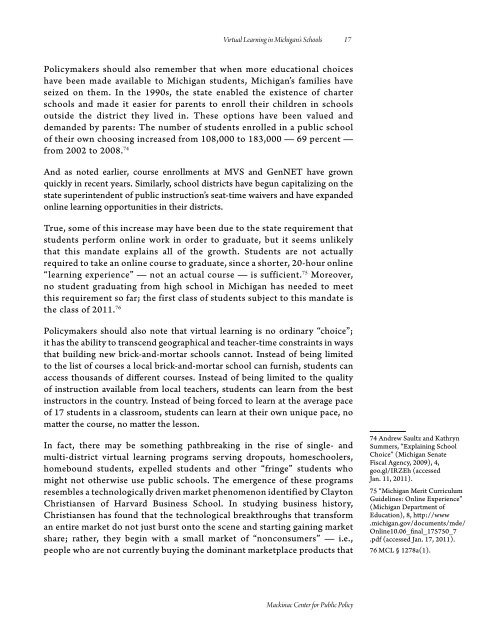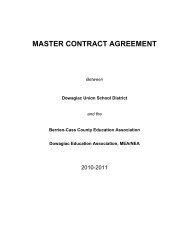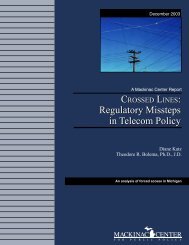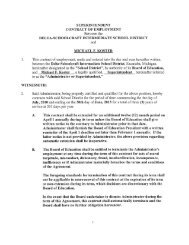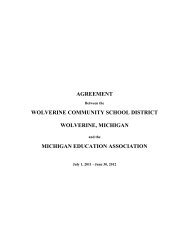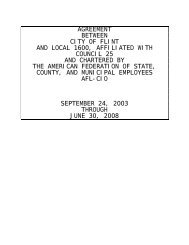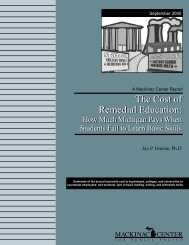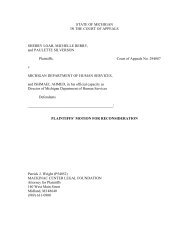by Michael Van Beek - Michigan Virtual University
by Michael Van Beek - Michigan Virtual University
by Michael Van Beek - Michigan Virtual University
Create successful ePaper yourself
Turn your PDF publications into a flip-book with our unique Google optimized e-Paper software.
<strong>Virtual</strong> Learning in <strong>Michigan</strong>’s Schools 17Policymakers should also remember that when more educational choiceshave been made available to <strong>Michigan</strong> students, <strong>Michigan</strong>’s families haveseized on them. In the 1990s, the state enabled the existence of charterschools and made it easier for parents to enroll their children in schoolsoutside the district they lived in. These options have been valued anddemanded <strong>by</strong> parents: The number of students enrolled in a public schoolof their own choosing increased from 108,000 to 183,000 — 69 percent —from 2002 to 2008. 74And as noted earlier, course enrollments at MVS and GenNET have grownquickly in recent years. Similarly, school districts have begun capitalizing on thestate superintendent of public instruction’s seat-time waivers and have expandedonline learning opportunities in their districts.True, some of this increase may have been due to the state requirement thatstudents perform online work in order to graduate, but it seems unlikelythat this mandate explains all of the growth. Students are not actuallyrequired to take an online course to graduate, since a shorter, 20-hour online“learning experience” — not an actual course — is sufficient. 75 Moreover,no student graduating from high school in <strong>Michigan</strong> has needed to meetthis requirement so far; the first class of students subject to this mandate isthe class of 2011. 76Policymakers should also note that virtual learning is no ordinary “choice”;it has the ability to transcend geographical and teacher-time constraints in waysthat building new brick-and-mortar schools cannot. Instead of being limitedto the list of courses a local brick-and-mortar school can furnish, students canaccess thousands of different courses. Instead of being limited to the qualityof instruction available from local teachers, students can learn from the bestinstructors in the country. Instead of being forced to learn at the average paceof 17 students in a classroom, students can learn at their own unique pace, nomatter the course, no matter the lesson.In fact, there may be something pathbreaking in the rise of single- andmulti-district virtual learning programs serving dropouts, homeschoolers,homebound students, expelled students and other “fringe” students whomight not otherwise use public schools. The emergence of these programsresembles a technologically driven market phenomenon identified <strong>by</strong> ClaytonChristiansen of Harvard Business School. In studying business history,Christiansen has found that the technological breakthroughs that transforman entire market do not just burst onto the scene and starting gaining marketshare; rather, they begin with a small market of “nonconsumers” — i.e.,people who are not currently buying the dominant marketplace products that74 Andrew Saultz and KathrynSummers, “Explaining SchoolChoice” (<strong>Michigan</strong> SenateFiscal Agency, 2009), 4,goo.gl/IRZEh (accessedJan. 11, 2011).75 “<strong>Michigan</strong> Merit CurriculumGuidelines: Online Experience”(<strong>Michigan</strong> Department ofEducation), 8, http://www.michigan.gov/documents/mde/Online10.06_final_175750_7.pdf (accessed Jan. 17, 2011).76 MCL § 1278a(1).Mackinac Center for Public Policy


